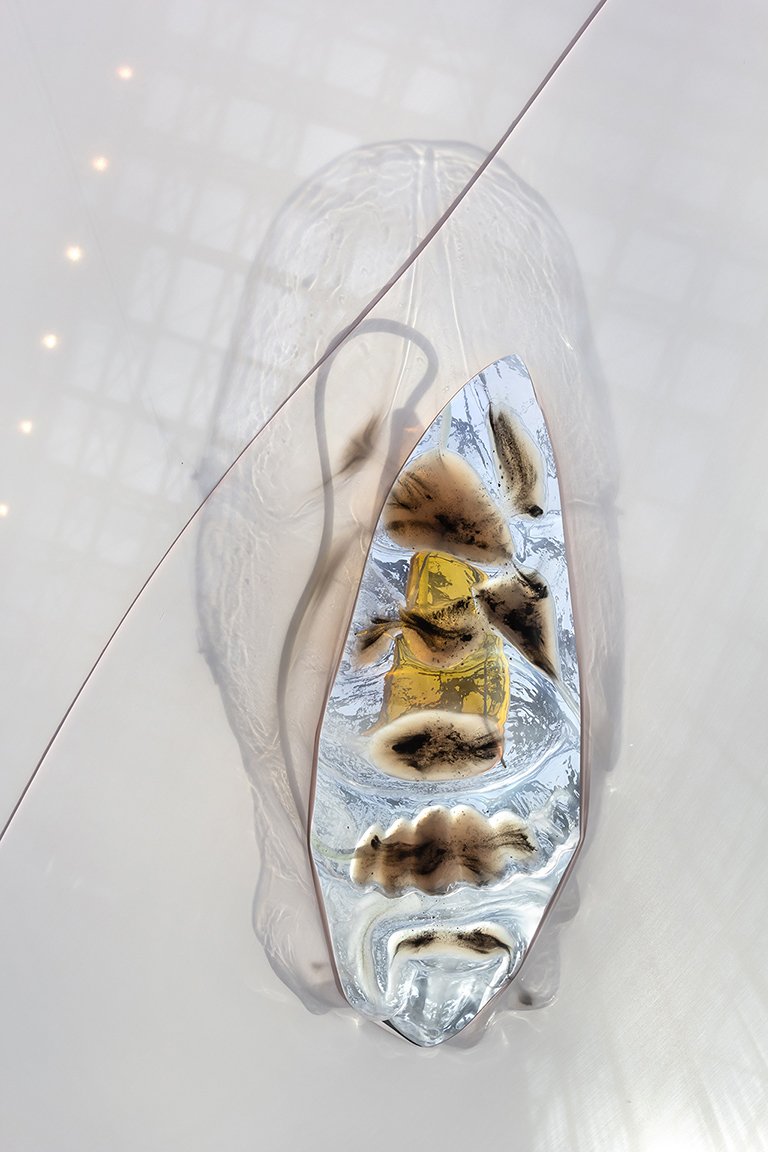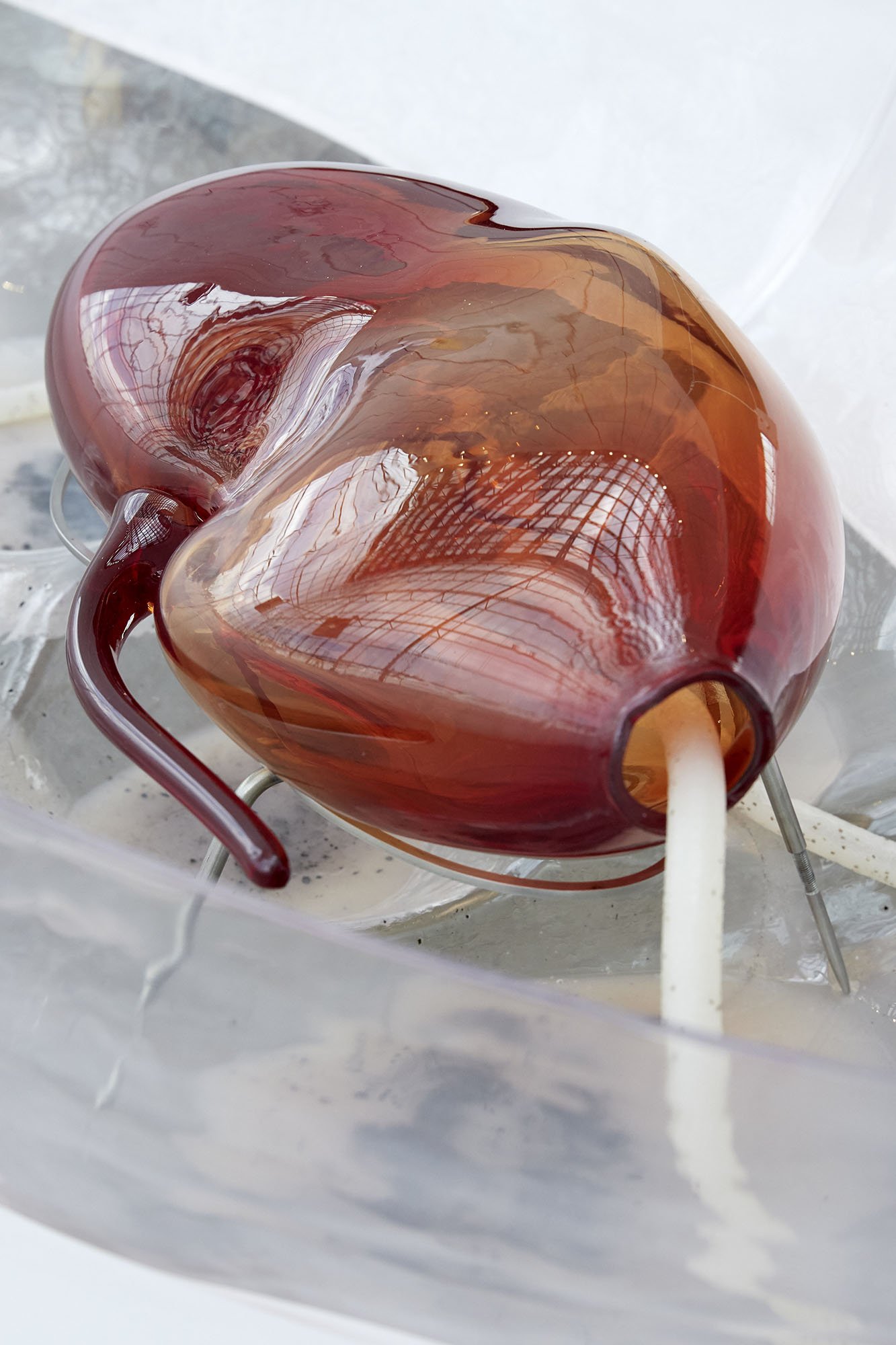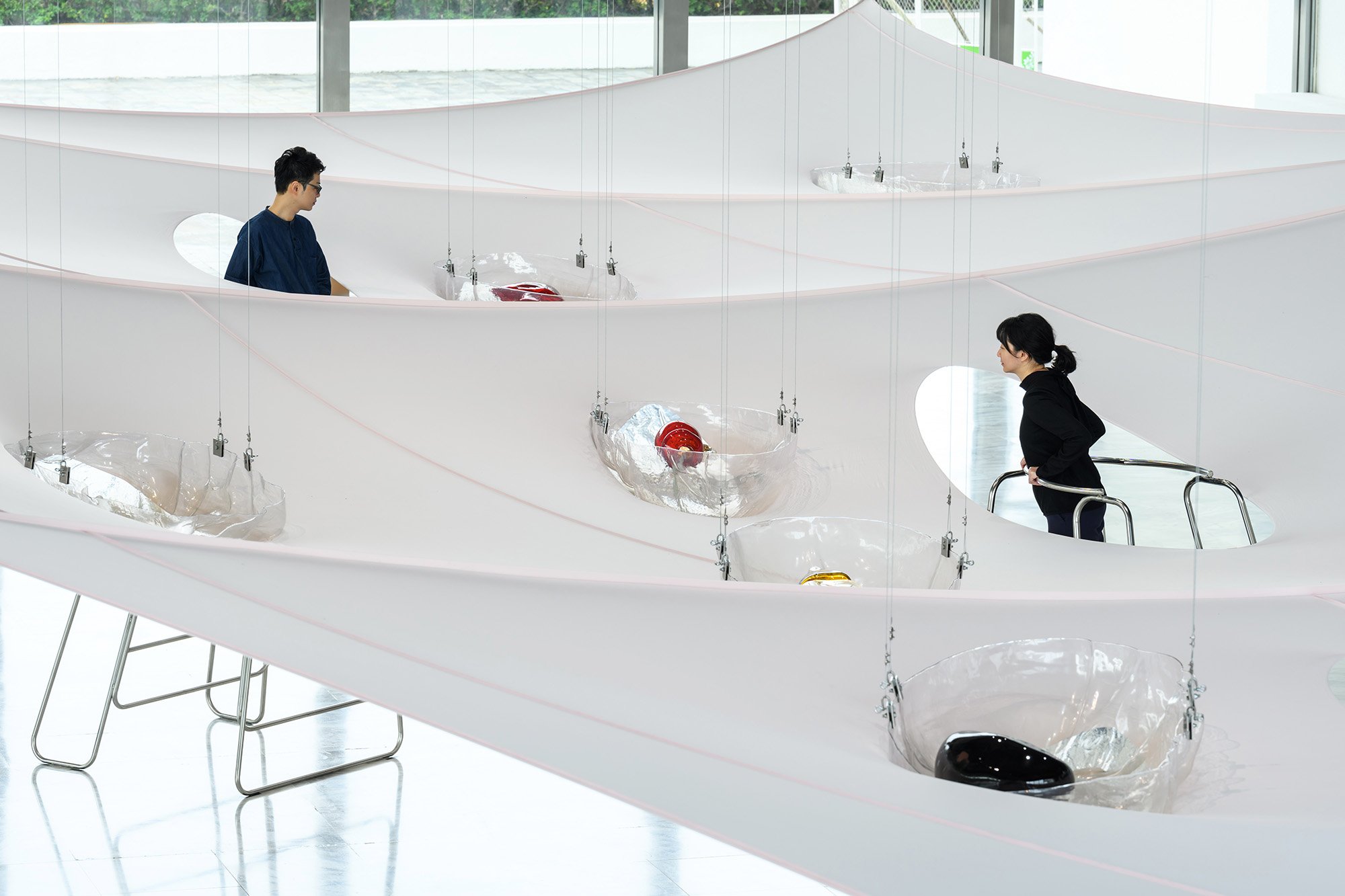Pakui Hardware
The Host, solo show at Eastcontemporary, Milan, Italy, 2021
Based between Berlin and Vilnius, Pakui Hardware is the artistic project led by Neringa Cerniauskaite and Ugnius Gelguda, which took the first steps in New York City in 2014. Over the years, they have defined a recognisable personal aesthetic and theoretical womb from which to nurture new unexpected ecosystems and life-forms. Looking at the relationship between contemporary technology, economy and bodily transformations, they are recently concerned with the concept of virtual care and automation of medical work. Our new robot companions help us rethink not only how centric is the role of labour in a capitalistic society, but also that human identity and “natural” bodies have vulnerable edges.
Virtual Care, solo show at BALTIC Centre for Contemporary Art, Gateshead, U.K., 2021
In Pakui Hardware installations, human, bacterial and robotic components intersect to redefine the established boundaries of the natural, in the attempt to reimagine a metamorphic body in constant becoming. A body open for inspection - as in Underbelly (2019), an environmental installation of an oversized belly exposing a sort of alienesque metabolism with glass guts and silicon limbs.
Subverting the exhibition space as an experimental ground for speculation, the visitor's voyeuristic gaze enters clinical surgery rooms occupied by alien hosts and prosthetic mechanical arms or laboratories for unexpected life-forms to grow.
The Return of Sweetness, solo show at Tenderpixel, London, 2018
Pakui Hardware is an artistic collective project growing between Berlin and Vilnius but born in New York in 2014. Due to its collaborative dimension, what brought Pakui Hardware to life in its concepts and materiality? And how do you work in conviviality to conceive your pieces?
Pakui Hardware was born during truly vibrant times – both in the art and theoretical worlds as well as for the emergence of such transformative technologies like smartphones and everything that followed. It was the time when speculative realism, new materiality, post-internet, and many other intriguing things were bubbling up and it was so exciting to be following all this so closely when living and working in NY. After years of so-called “archival turn”, it felt so refreshing that art and theory were finally addressing contemporaneity and the future rather than enclosing themselves in the art for art’s sake tower, acting as if there is still some kind of autonomy, or externality to the global capitalist system.
Over the years of working together on bringing Pakui Hardware up, we went through many transformative phases, until finally it seems that Pakui Hardware has become an adjective: there is something very particular about the way material combinations perform in the works, bringing to a certain kind of aesthetic that is recognizable as specifically ours. So we keep receiving messages from people where they tag various objects around them – from dishes to interiors – reminding them of Pakui Hardware’s work. It’s quite incredible!
We both come from slightly different backgrounds – Ugnius comes more from the field of photography and new media, while Neringa studied art history, curating and semiotics – which makes quite an interesting and sometimes challenging combination. However it makes it easier to test ideas and visions by confronting each other and see if they work. On large-scale exhibitions we tend to collaborate with our dear architects friends Ona Lozuraitytė and Petras Išora with whom we have been working since 2016 for our solo show Vanilla Eyes at MUMOK museum in Vienna.
Hesitant Hand. Group show Citynature - Vilnius and Beyond at the National Gallery of Art, Vilnius, 2017
The sculptures refer to different kinds of bodies: robotic, bacterial, human, etc. intersecting in a post-natural way. The austerity of steel, the fragility of glass vessels resembling guts and stomachs, the transparency of skin-like silicone tissues,..., all these materials combine to introduce a new type of hybrid body. How does research in materials reflect on the vulnerable concept of the body?
Each new work invites new materials. You partially answered this in your own question: combinations of fragile and rigid, synthetic and organic, transparent and opaque materials, surfaces and textures refer to bodies in transformation, bodies in becoming. So it happens that most of our works evoke the sense of fragility in the viewers, making them hold their breath while they walk around the sculptures as if the pieces might crumble or evaporate at any moment. At least many recounted those experiences to us. Another emotion we have heard a lot from the viewers is the sense of uncanny – the pieces or installations attract and repel at the same time, confusing one’s perception of both the works and one’s own body.
We consciously select materials that could carry a certain cultural, social or historical reference or provoke emotional response. Glass appeared in our practice a few years ago, when working on the series The Return of Sweetness, in which glass stomach sculptures referred to anatomical models one encounters in anatomy museums. While faux-fur and natural leather together with silicone patches plays around with preconceived notions on natural and artificial, demonstrating the non-existent boundaries between the two realms. Translucent thermoformed Plexi bodies create a dimension of virtuality and exposure – something that is open for your inspection yet evasive and seems to oscillate between physical and virtual. As in the Underbelly or Virtual Care series. Our latest body of work – Skewed Taxonomy – specially conceived for the Kaunas Biennial and the Kaunas Zoological museum, incorporates actual wasp nests as parts of imaginary future fossils displayed in the museum among other actually existing specimens. Thus, through different mixtures of materials we speculate on the plasticity and potentiality of bodies to become.
Creatures of Habit, solo show at SIC, Helsinki, 2017
Previous works shown in exhibitions like Hesitant Hand (2017) and Creatures of Habit (2017) were orbiting around the discourse on automation of work and gestures both by humans and our new companions, robots. You have recently continued these investigations through Virtual Care (2021) and The Host (2021), which took place in spaces resembling clinical surgery rooms inhabited by prosthetic mechanical arms, in reference to the automation of medical labour. How do you believe machine automation is changing the aspects of life, such as work, relationships and identity?
It creates a mess. But also in a good way, ‘cause it forces to reconsider a number of positions that were taken for granted. For example, why do human workers still need to do such mechanical labour that could be taken over entirely by machines? Because human labour is still cheaper and because the current economic regime fails or refuses to reconsider the entire faulty wage system as well as social security. In industrial automation, robots provoke us to reconsider the notion of labour itself — does it still need to be the central axis of life around which everything circles? Industrial robots also made us speculate about the relationship of the vulnerable human body, which tends to deteriorate and drown in fatigue, however its plasticity and precision is still unreachable for many industrial robots. Not to mention robotic surgeons or chefs. It shows how much we still don’t know about the human body itself and how much emphasis is paid on efficiency and programmed intelligence without thinking that it is always an embodied intelligence and how much they are in sync and how much they shape each other.
Technological transformation of the care system too invites to reconsider such key notions as ‘warm’ human attention and ‘cold’ technological vigilance. In Virtual Care or The Host we attempted to blur these boundaries, exploring the situations in which technology might create a sense of care no less than an overworked and exhausted medical practitioner would provide. The question is extremely wide and therefore it constantly provokes artists and thinkers alike to make new pieces on this subject. It definitely cannot fit into one short answer.
Underbelly, solo show at MdbK Leipzig, Germany, 2019
Organic/synthetic nutrients such as chia seeds or liquid silicone occupy the inner space of sculptures resembling digestive apparatus in their components and functions. What interests you when it comes to these elements and systems?
This subject allows us to reflect on metabolism – both as a biophysical process and as a metaphor for a human-nature relationship. Metabolism binds together notions and elements such as resources, energy, efficiency, capital, health issues, and, finally, the metabolic rift.
In The Return of Sweetness, for example, we tried to track how a metabolism, which used to exist on its own in terms of velocity and efficiency, is being monitored and controlled from the outside. One is constantly pushed to boost one’s metabolism, yet at the same time we live in the great nutritional decline where even fruits and vegetables don’t contain necessary vitamins for healthy living. Not to mention the economic gap which allows only a fraction of society to afford organic food and a healthy lifestyle. We looked at how bariatric surgery basically sculpts the human stomach, squeezes it, folds it, removes parts of it… So we tried to expose this invasive relationship with organisms, showing its post-natural state in which every molecule is wired for efficiency or is abandoned.
In this work, metabolism has also been taken as a metaphor derived from the writings of Mckenzie Wark and their book Molecular Red in which they talk about “metabolic rift” – a point at which the reciprocal relationship with nature loses its balance and the metabolic process gets out of control. In Wark’s words: “Labor pounds and wheedles rocks and soil, plants and animals, extracting the molecular flows out of which our shared life is made and remade. But those molecular flows do not return from whence they came''. Thus “The Anthropocene is a series of metabolic rifts, where one molecule after another is extracted by labour and technique to make things for humans, but the waste products don’t return so that the cycle can renew itself.” The Return of Sweetness attempted to expose this metabolic rift both as a global and more general issue and as physical transformation of human bodies.
Underbelly, solo show at MdbK Leipzig, Germany, 2019
Your pieces are linked to the specificity of the space they occupy, sometimes they are actual environments with which the viewer can interact — as in Underbelly (2019). How do you conceive these installations in relation to the exhibition environment?
Space is crucial to our practice. The specific qualities of each space – the light, architectural rhythm, atmosphere, textures and even smells provoke unique visions for each installation. Therefore it is quite frustrating when we need to produce just one sculpture for a group show or a fair in which space is just some square meters in a room, without any context or ambiance. We always try to build environments rather than groups of individual pieces, environments in which the viewer might sometimes even feel as an intruder or a voyeur. For Underbelly we transformed the enormous amount of light into an organic-like colour that was emanating from the giant pinkish membrane stretched over the room, this way invoking a sense of entering a huge organism, a belly perhaps. While in Vanilla Eyes (2016) in MUMOK we attempted to make the -2 floor of the museum into a fictional laboratory for unknown forms of life to grow and thrive. In Virtual Care, we changed the wooden floor of the BALTIC Centre for Contemporary art into a grey hospital-like linoleum and transformed the usually quite cozy space into a kind of surgical room environment. Again, we worked with the architects for the aforementioned projects.
Underbelly. Group show The Modern Exorcist at Taipei Fine Arts Museum, Taipei, Taiwan, 2021
Do you have any new upcoming projects or field of interests you would like to explore next?
We’re continuing to explore the relationship between contemporary medicine, economy and bodily transformations. Especially in the notion of inflammation as it is explored in the work of the physician Rupa Marya and the political economist Raj Patel in which they relate inflammation of the human body to the flaming body of Earth. It is a truly interesting and relevant take on inflammation as a healthy response of bodies to a sick environment and traumatic history. They suggest to employ Deep Medicine – a way to understand humans as part of the thick web of life rather than a fragmented entity. To learn this, we can look at indigenous cosmologies and knowledge, but not in a patronising way or by appropriating it, but by humble learning and appreciation. There is so much to explore yet!
Breed, ArtBasel Parcours at Novartis Campus, Basel, Switzerland, 2021
interview FEDERICA NICASTRO
What to read next
















